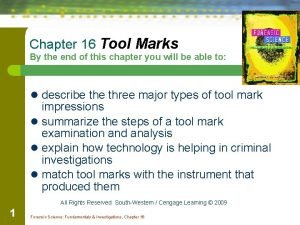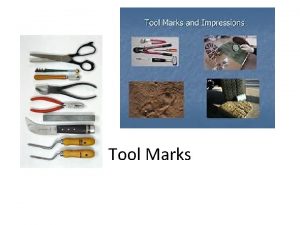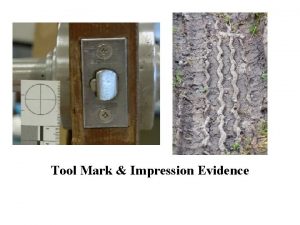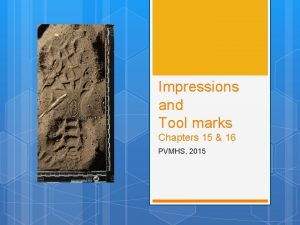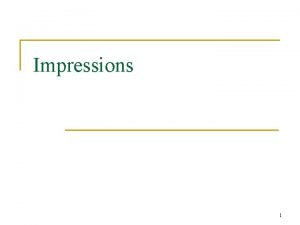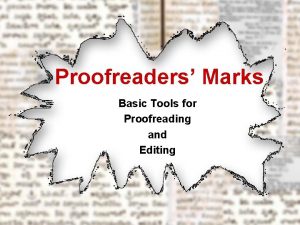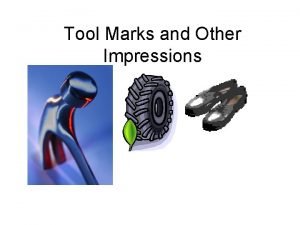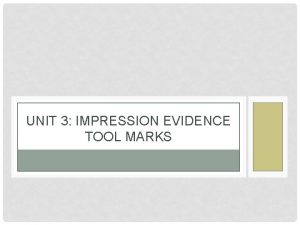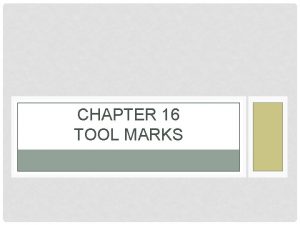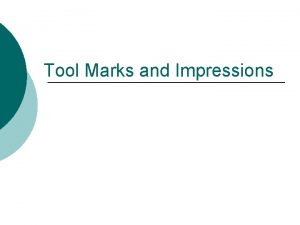Tool Marks Tool Marks What are tool marks












- Slides: 12

Tool Marks

Tool Marks • • • What are tool marks? How can tool marks help make a case? If you and I own identical pry bars, how can a forensic scientist identify which one was used at a crime scene?

Tool Marks Tools make specific marks when they cut or scrape a softer surface Compression tool mark: shows outline of tool (hammer into wood) Sliding tool mark: parallel striations when tool slides across material (screwdriver or crowbar) Cutting tool mark: striations when tool cuts through material (scissors)

2 Types of Characteristics 1. Class characteristics 1. Common to a group of objects 2. Example: A hammer has a distinctive shape and size. 2. Individual characteristics 1. Unique to a given object 2. Causes? 3. Example: shoes

Types of Tool Mark Impressions 1. Static (“impressed”) marks – Caused by a harder object being pressed into another softer object – Example: crow bar into wood 2. Dynamic (“striated”) marks – Caused when a tool slides or scratches across another surface – Example: sliding a key along the side of a car (Locard? )

Types of Tool Mark Impressions, cont… 3. Cutting (“crushed”) marks – Caused by pressure being applied to both sides of an object – Examples: pliers or wire cutters 4. Multi-stroke marks – Caused by repetitive actions – Example: a saw moving back and forth

Collection of Tool Marks § Notes, sketches, photographs § If possible, the tool mark should be taken back to the lab. § If not, a cast should be made. Silicone rubber ideal material

Collecting Tool Mark Evidence • What do you think the FIRST step would be? • 2 nd step: – Bagged and taken to lab for further analysis, if possible – Make a cast of the marks, usually with silicone rubber. • What do you do with a recovered, suspect tool?

Examination of a Suspect Tool • Step 1: ? • Step 2: ? • Make test marks with the tool. • What piece of equipment would you use to compare the marks made in the lab with the marks made at the scene? • What other evidence can be obtained from a suspect tool?

Conclusions of analysis § If class characteristics and striations match, can say the tool mark was likely made by the suspect. § If class characteristics (and striations) do not match, the suspect tool can be excluded. § If class characteristics match but striations do not, the results are inconclusive.

Case Study • Leah and Milton Rosenthal: http: //www. channel 4. com/science/micr osites/S/science/society/forensic_marks. html • The Lindbergh Kidnapping

 Insidan region jh
Insidan region jh Sentences with exclamation marks
Sentences with exclamation marks Abrasion marks are made by objects, which include:
Abrasion marks are made by objects, which include: Static marks
Static marks Some factors that personalize our footwear include:
Some factors that personalize our footwear include: Indentation tool marks
Indentation tool marks Why are footprints easier to cast than tire tracks
Why are footprints easier to cast than tire tracks When was rifling invented
When was rifling invented Potter's wheel data cleaning tool
Potter's wheel data cleaning tool Marks and numbers
Marks and numbers Basic editing marks
Basic editing marks Types of impressions
Types of impressions Function of quotation marks
Function of quotation marks


